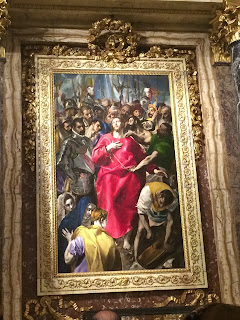1.
Explain why you selected the video you choose
from the selection listed above.
I chose Beyond
the Classical: Byzantine and Later Greek Art because I have always been
intrigued by ancient Greek history and art. In fact, I am currently studying to
become a history teacher so I often take any chance I get to learn more about
different countries and cultures.
2. For each video list/discuss the key concepts you learned.
For More Human than Human I learned that
cross-culturally and throughout history, humans have been inclined to make art
that reflects their culture and brain wiring. In the case of The Venus of Willendorf, which is
a small figure with exaggerated breasts, hips and sexual organs, the people who
created her reflected their ideal body standards onto that statue. They lived
in a barren ice age where food was scarce therefore their ideal human body was
cubby which indicated being well fed. Dr Ramachandram, who we watched
previously this semester, also explained that art needs to be exaggerated to be
interesting.
I learned that this relates to our modern
world because men who create statues of woman often also exaggerate a smaller
waist and bigger breasts. Photo-shopped models are also used as a form of art,
in every case these bodies are unrealistic for the everyday woman to achieve,
but are created and viewed anyways because they reflect an aspect of our
culture obsessed with sexualizing women.
For the second video I learned that during the
Byzantine Period in ancient Greece the Catholic Church encouraged the
destruction of many classical statues and works of art because it was seen as
worshiping a different idol than god, especially in regards to art pertaining
to Greek Gods like Zeus or Poseidon. I also learned that neoclassicism was the
attempt to bring the classic style of art of ancient Greece to modern Europe.
This neoclassicism is seen especially in architecture that is designed to look
like ancient Greek buildings.
3. How do the videos relate to the readings in the text?
Both the reading and the videos dealt with
art being influenced by culture and historical time period. The first video I watched
related most to chapter 14, the Ancient Mediterranean Worlds. It related to
this chapter because it discussed ancient Egyptian, Greek and Italian art.
The video I chose myself related most to chapter
15, Christianity and the Formation of Europe. It related to this chapter
because it discussed the rise of Christianity in Ancient Greece and the rise of
the Byzantine Empire and the Middle ages and the affects it had on art styles.
4.
What is your opinion of the films? How do
they add depth to understanding of the readings and art concepts?
I found the first video extremely
interesting. I liked how the narrator went through multiple periods of history
for multiple parts of the world and related it to how art reflected their
culture. I also enjoyed the second video I watched. I liked how they went
chronologically through the art history in Greece relating it to the different
historic events and rulers that influenced the art as well.
Chapters 14 and 15 are all about art
throughout time. The first video related to this because it was all about how
art reflects the culture and values of the people who created it. Both the book
and the video mention The Venus
of Willendorf, however the video goes much more into depth onto why it
looks the way it does. The book and the video also both mention Ancient Egypt
and why the human body is often depicted with weird angles of the body, the
video expanded on this by showing the narrator being turned into an Ancient
Egypt figure. Also, the first video goes more into depth onto the positioning of
the ancient Greek statues, including the background information on “Warrior A”.
The
second video related to the chapters because it talked about the influence of Christianity
on ancient Greece. Specifically, the practice of icon painting and the
Byzantine Empire. The video, however, expands on the effects of Ancient Christianity
in the modern world.


